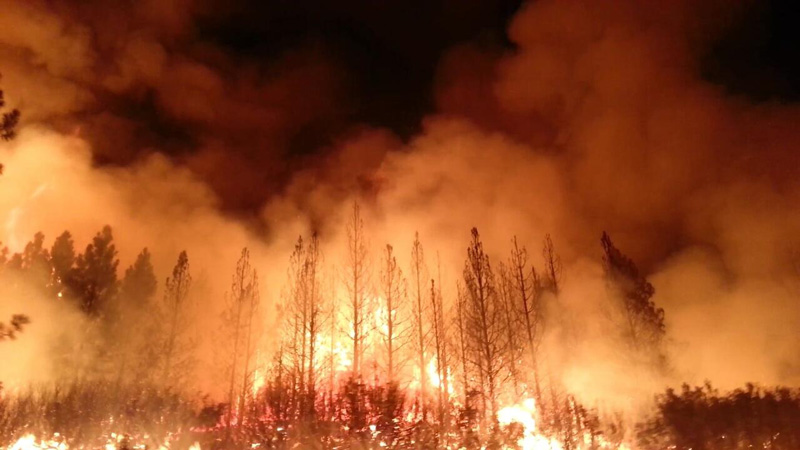As fire season picks up, firefighters tasked with protecting lives, property, and nature are especially prone to deleterious, long-term health effects like cancer. Among the first steps in evaluating health risks posed to firefighting is understanding sources of toxic chemical pollutants.
A team of scientists led by Heather Stapleton, an environmental scientist at Duke University affiliated with the Duke Cancer Institute, used a combination of silicone wristbands (like the once ubiquitous cause-awareness bracelets) and surveys to track exposure and activities of structural firefighters who typically respond to building and car fires. In their first study on the topic, published in Science of the Total Environment, the team measured 134 different chemicals on wristbands worn by firefighters for 6 days in three different scenarios—on duty and fighting fires, on duty with no fires, and off duty. In each scenario, different chemical species spiked. Working together, scientists and firefighters can begin to parse relative differences in pollutant sources and connect them with human health.
Working Together
Worried about the well-documented cancer risks faced by structural firefighters, the Durham Fire Department in North Carolina approached the Duke Cancer Institute, resulting in collaborative efforts to confront their concerns. Stapleton and her coauthors focused on one aspect of the fire department’s queries: What are the differences in the firefighters’ exposure to chemical pollutants while on and off duty?
“Firefighters can put on their wristbands and forget about them.”
Stapleton’s team designed the study with firefighter input, alighting on a combination of silicone wristbands and surveys, said Jessica Levasseur, a doctoral student and first author. “You don’t want to add anything to [firefighters] that can put them at greater risk.” Silicone can record the presence of certain chemicals, and firefighters can put on their wristbands and forget about them, she said.
To understand the wristband data, said Stapleton, “we needed to know more about their daily activities.” The surveys, conducted at the end of each 6-day scenario, let firefighters easily document whether they responded to a fire while on duty and track their off-duty pursuits.
Connecting Exposures to Health
The wristbands revealed increased concentrations of certain compounds when the firefighters fought fires, said Levasseur. These compounds included carcinogenic polycyclic aromatic hydrocarbons (PAHs) produced by burning organic matter (think forest fires or combusting gasoline, especially fire engines idling in a forest) and some potentially hormone disrupting flame retardants (often found in furniture and home electronics).
For other chemicals, “there is a clear occupational exposure that is independent of the fires,” said Pierre Herckes, an atmospheric scientist at Arizona State University who was not involved in this study.
Exposure to some phthalates, which carry fragrances and make materials like plastic packaging and tubing more flexible, was higher in off-duty wristbands, indicating that these exposures occurred at home, Levasseur said. “We’re not commenting on what got into people’s bodies, but we’re saying that this is what they were exposed to while they were wearing the wristband.”
For their next study, Stapleton’s team is conducting blood and urine sampling at the beginning and end of a 4-month study period to identify changes in firefighters’ bodies that might reflect cumulative exposure. Combined with wristband and survey data, this information can connect pollutant sources and exposure to biological changes.
Wildland Versus Structural Fires
Wildland firefighters—those who fight wildfires—are fewer in number and often work seasonally. As a result, they are harder to track, and less is known about their cancer risk, said Jeff Burgess, a professor of public health at the University of Arizona who was not involved in the Duke study. He’s currently leading cohort studies including both structural and wildland firefighters in the United States and is planning to incorporate wristbands into the ongoing wildland firefighter studies in collaboration with Stapleton and others.

Wildland firefighters often fight fires with neither respiratory protection nor heavy personal protective gear, said Burgess.
In particular, wildland firefighters wear flexible, lightweight clothing with bandanas over their faces, said Jeff Hughes, a recently retired Orange County, Calif., fire captain who has fought both types of fires. “When you’re running up and down the hills carrying a ton of weight…wearing [respiratory protection] over your face is a challenge,” he explained.
Wildland firefighters also fight campaign fires—large wildfires whose suppression requires a highly coordinated response. Whereas structural fires tend to last a few hours at most, campaign fires can last for days, with teams working for 2 to 3 weeks at a time, Hughes said.
Wildland and structural fires (as well as firefighting techniques and equipment) can sometimes overlap. Fires in the wildland-urban interface (WUI) often begin as brush fires but can engulf entire neighborhoods. When structural firefighters respond to brush fires, they’re usually sans heavy-duty protection but end up working long hours as both nature and the built environment burn.
The recent Coastal Fire in Orange County, for instance, began as a vegetation fire but became a WUI fire when buildings were consumed by the flames. Responding firefighters came dressed for a brush fire, said Hughes, but ended up exposed to the pollutants typical of a structure fire. Moreover, the Coastal Fire burned many electric cars, adding chemicals from lithium-ion batteries to the air.
“It’s a big dose [of chemicals],” said Hughes.
In assessing health risks to firefighters, the way forward may be the kind of community-engaged research that Stapleton and Burgess are pursuing. “The questions [about exposure] come from the firefighters,” said Burgess, “[and] the firefighters are able to use that information to make…their jobs safer.”
—Alka Tripathy-Lang (@DrAlkaTrip), Science Writer
This news article is included in our ENGAGE resource for educators seeking science news for their classroom lessons. Browse all ENGAGE articles, and share with your fellow educators how you integrated the article into an activity in the comments section below.


